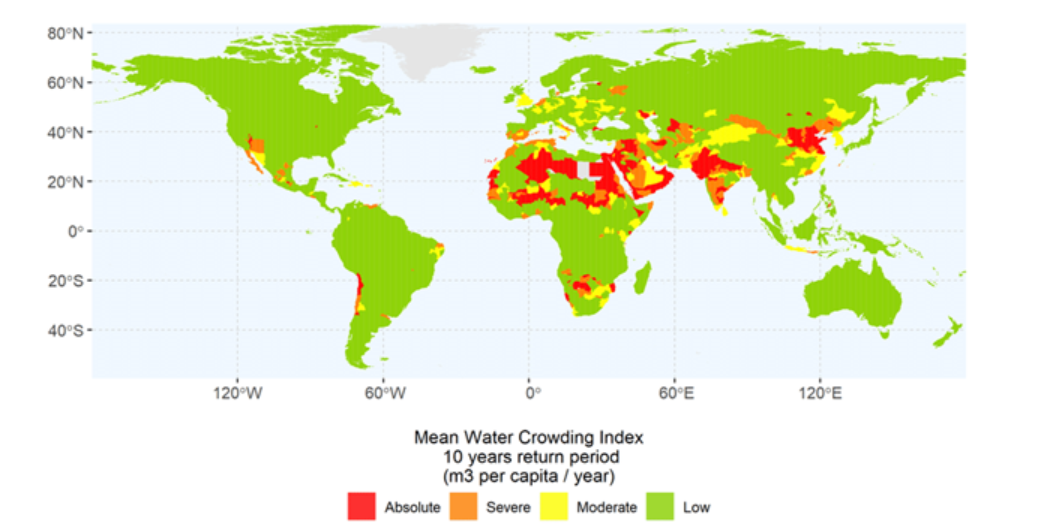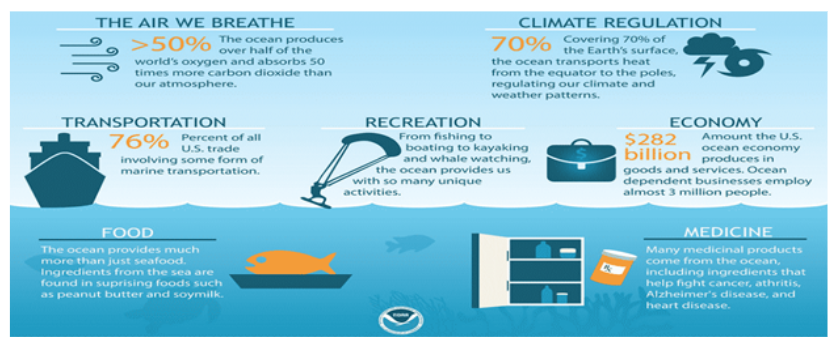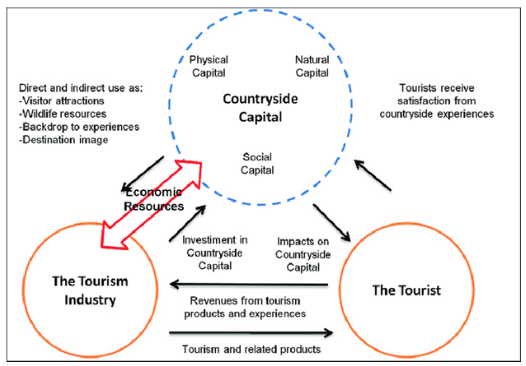24 Oct to 10 Nov, 2023
100 MILLION HECTARES OF ARABLE LAND LOST YEARLY TO DEGRADATION : UN REPORT
Why in news : The UN Convention to Combat Desertification (UNCCD) announces the launch of its first-ever Data Dashboard compiling national reporting figures from 126 countries, which shows that land degradation is advancing at an astonishing rate across all regions.
About :
LAND DEGRADATION
- Land degradation refers to the decline in the quality and productivity of land due to various factors like soil erosion, overgrazing, deforestation, and pollution. For example, repeated and unsustainable farming practices can deplete soil nutrients, reducing its capacity to support crop growth.
- Desertification, a severe form of land degradation, involves the transformation of fertile lands into arid deserts. For example, prolonged drought and poor land management can lead to desertification, turning once-productive regions into barren wastelands, like the Sahel region in Africa.
FACTORS FOR LAND DEGRADATION AND DESERTIFICATION
- Climate and Precipitation Patterns: In arid and semi-arid regions, low and erratic rainfall contributes to land degradation and desertification. Extended droughts can deplete soil moisture and reduce vegetation cover. Example: The Sahel region in Africa has experienced persistent droughts and declining precipitation, leading to desertification and land degradation
- Soil Erosion: Geographical factors such as steep terrain and high-intensity rainfall events can accelerate soil erosion. Deforestation, overgrazing, and improper land use practices exacerbate this issue. Example: The Loess Plateau in China faces severe soil erosion due to its hilly terrain and intensive agriculture.
- Land Use and Agriculture: Unsustainable agricultural practices, such as continuous cropping and excessive use of chemicals, deplete soil nutrients and degrade land. Example: The Midwest United States has seen soil degradation from extensive monoculture and intensive farming practices.
- Salinization and Water Management: In irrigated areas, improper water management can lead to the buildup of salts in the soil, rendering it infertile. Example: The Aral Sea region has faced salinization due to excessive irrigation without adequate drainage, contributing to desertification.
IMPACTS OF LAND DEGRADATION AND DESERTIFICATION
- Loss of Arable Land: Land degradation and desertification reduce the availability of fertile soil for agriculture, leading to food security concerns.The Food and Agriculture Organization (FAO) estimates that over 33% of the Earth's land surface is affected by desertification and land degradation. In parts of Sub-Saharan Africa, such as Mali and Niger, land degradation has reduced the agricultural potential, affecting food production.
- Biodiversity Loss: Land degradation reduces habitat quality and disrupts ecosystems, leading to biodiversity loss. The Intergovernmental Science-Policy Platform on Biodiversity and Ecosystem Services (IPBES) reports that land degradation threatens 24% of global land area and negatively impacts biodiversity.
- Human Migration and Conflict: The United Nations recognizes the role of desertification and land degradation in displacement and potential conflict. Example: In parts of Central Asia, the Aral Sea's desiccation due to land degradation forced local communities to migrate, contributing to regional tensions.
- Climate Change Feedback: Land degradation contributes to climate change by releasing stored carbon in soil and vegetation.Deforestation and soil degradation in the Amazon basin release significant amounts of carbon, impacting global climate.
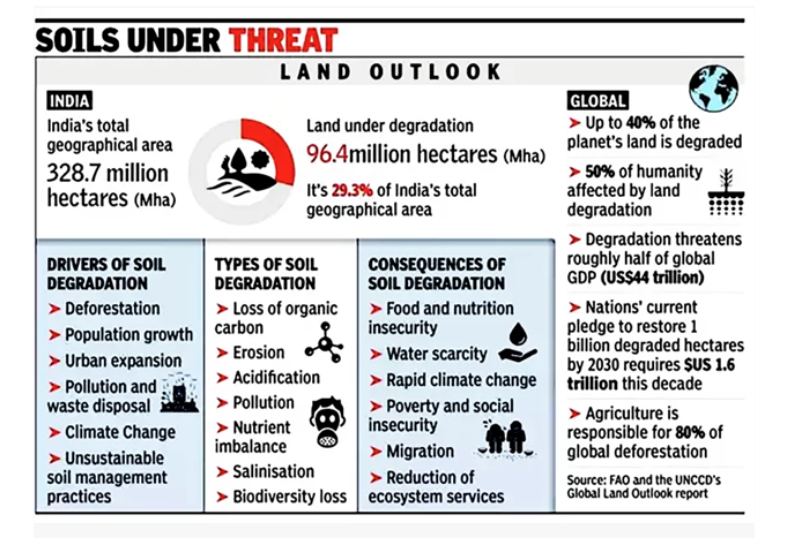
KEY FINDINGS OF UNCCD ON LAND DEGRADATION
- Extent of Land Degradation: From 2015 to 2019, the world experienced an annual loss of at least 100 million hectares of healthy and productive land, equivalent to twice the size of Greenland.
- Regional Disparities: The most severe land degradation is observed in Eastern and Central Asia, as well as Latin America and the Caribbean, affecting over 20% of their total land area.
- Faster Degradation: Sub-Saharan Africa, Western and Southern Asia, Latin America, and the Caribbean are witnessing land degradation rates surpassing the global average.
- Notable Loss: Since 2015, Sub-Saharan Africa and Latin America and the Caribbean have lost 163 million and 108 million hectares, respectively, to land degradation.
- Land Restoration “Bright spots”: Several countries have made notable progress in land restoration:
- Botswana reduced land degradation from 36% to 17% of its territory and allocated 45.3 million hectares to land-degradation neutrality, identifying 1.42 million hectares as "bright spot" areas.
- The Dominican Republic decreased degraded land from 49% to 31% between 2015 and 2019 and continues efforts to restore 240,000 hectares.
- Uzbekistan, despite having the highest proportion of degraded land (26.1%) in Central Asia, reduced it from 30% to 26% since 2015. The country also planted saxaul trees on 1.6 million hectares to combat the drying of the Aral Sea.
- Land Degradation Neutrality (LDN) Goal Achievability: To meet the Sustainable Development Goals, the world must restore 1.5 billion hectares of degraded land by 2030 if current land-degradation trends persist.
- Sustainable Development Goal 15: Sustainable Development Goal 15, known as "Life on Land," calls for the protection, restoration, and sustainable management of land-based ecosystems. Specifically, Target 15.3 aims to achieve a world that is neutral in terms of land degradation by 2030.
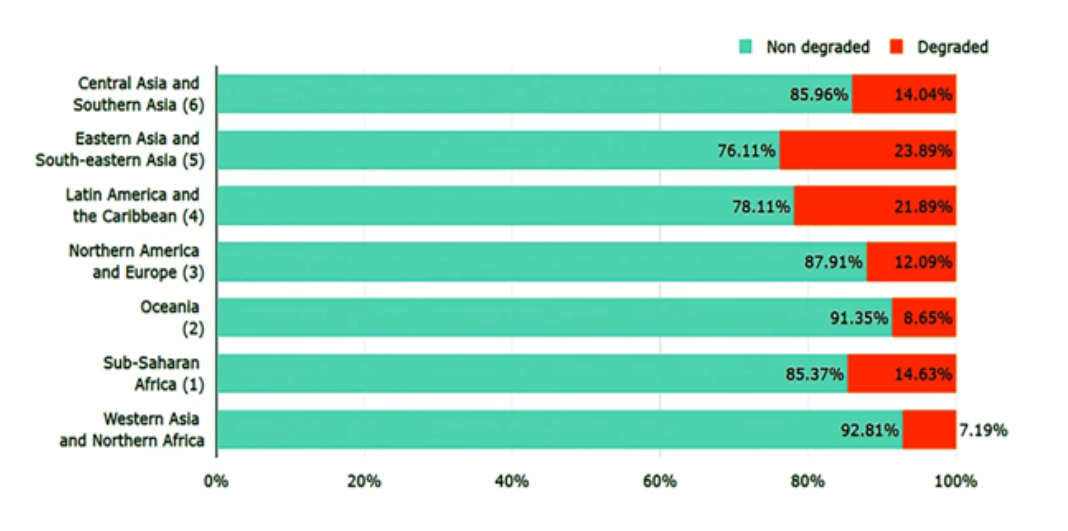
CLIMATE CHANGE AND LAND DEGRADATION
- Carbon Sink: Forests act as a crucial carbon sink, absorbing carbon dioxide from the atmosphere and storing it in trees and soil. Deforestation and degradation release this stored carbon, contributing significantly to greenhouse gas emissions. The Intergovernmental Panel on Climate Change (IPCC) reports that deforestation and forest degradation are responsible for around 11% of global greenhouse gas emissions.
- Positive Feedback Loop: Climate changes can lead to more frequent and severe forest fires, insect infestations, and diseases that harm forests.Example: The increased frequency of wildfires in the Amazon rainforest due to drier conditions linked to climate change is a significant concern. These wildfires release vast amounts of stored carbon.
- Impact on Biodiversity: Climate change further exacerbates this issue by altering the habitats and migration patterns of many species. Example: The impact of climate change on polar bears is a well-documented example.
- Altered Precipitation Patterns: Climate change can cause shifts in rainfall patterns, leading to droughts or excessive rainfall in some regions. A study published in the journal Nature Climate Change found that climate-induced droughts in the Amazon can increase tree mortality, making the forest more susceptible to degradation.
- Human-Induced Factors: The expansion of oil palm plantations in Southeast Asia is a significant driver of deforestation, while the use of fossil fuels for transportation and energy production contributes to climate change.
|
CASE STUDY : LAND DEGRADATION IN PUNJAB Punjab, known as India's "Granary," has experienced severe land degradation over the years, primarily due to intensive agriculture practices. Heavy reliance on monoculture, excessive use of chemical fertilizers, and pesticides has resulted in reduced soil quality and declining crop yields. Excessive groundwater extraction for irrigation has led to a declining water table, especially in the regions of Majha. Due to water logging and salinity , vast expanse of arable land has been lost in Doaba region. ( Jalandhar and Kapurthala) |

REGIONAL VARIATIONS IN INDIA AND THEIR IMPLICATION FOR LAND DEGRADATION AND DESERTIFICATION
- Thar Desert (Rajasthan): The Thar Desert experiences severe desertification with expanding sand dunes. Water scarcity is a major concern, and the practice of excessive groundwater extraction for agriculture contributes to land degradation. Crop failure and livelihood challenges are widespread.
- Indo-Gangetic Plains (Punjab and Haryana): These regions face land degradation due to intensive agriculture, monocropping, and heavy use of chemical inputs.
- Western Ghats (Kerala and Karnataka): Landslides and flash floods are frequent in the monsoon season, impacting agricultural practices and infrastructure in the parts of Western Ghats
- Eastern India (Bengal and Odisha): Cyclones, flooding, and poor drainage lead to waterlogging and salinity in low-lying areas.
- Himalayan Region (Himachal Pradesh and Uttarakhand): The fragile ecosystems of the Himalayan region are threatened by deforestation, landslides, and erratic rainfall patterns.
GLOBAL INITIATIVES TO CONTROL LAND DEGRADATION AND DESERTIFICATION
|
INITIATIVES |
OBJECTIVES |
|
United Nations Convention on Combating Desertification |
|
|
Bonn Challenge |
|
|
Great Green Wall Initiative |
|
INITIATIVES TAKEN BY INDIA
|
National level land degradation mapping |
It is taken up by ISRO towards generating information on land degradation at 1:50,000 scale, using 23m resolution |
|
Desertification and Land Degradation Atlas of India |
Provides a state wise area of degraded lands. |
|
Pradhan Mantri Fasal Bima Yojana
|
To encourage farmers to adopt innovative and modern agricultural practices to mitigate degradation |
|
Soil Health Card Scheme
|
Provides information on the nutrient status of soil, along with recommendations on the dosage of nutrients to be utilised for improving its fertility of land. |
WAY FORWARD
- Promoting resilience against desertification, land degradation, and drought can lead to lasting socio-economic advantages for individuals residing in arid regions while also diminishing their susceptibility to climate change impacts.
- Land Degradation Neutrality (LDN) offers a robust structure, underpinned by the principles of preservation, sustainable utilization, and rehabilitation, to combat these challenges effectively.
- Establishing a conducive environment for LDN empowers policymakers and planners to carefully navigate the intricate balance among societal, economic, and environmental aspects. This approach ensures that critical considerations such as food security, energy requirements, land tenure, gender equality, access to clean water, and biodiversity are collectively recognized and dealt with.
Where to use ?
Paper 1 ( Geography Optional ) : Erosion and Degradation
Paper 2 ( Geography Optional ) : Ecological issues , Environmental degradation, Sustainable Development Goals
LESSONS FROM PAT SCHEME
Why in news : India is all set to steer towards a regulatory carbon market in the country, ahead of its announcement in the Energy Conservation Amendment Bill passed in December 2022.
About :
- The PAT Scheme, known as Perform, Achieve, and Trade Scheme, was initiated by the Bureau of Energy Efficiency (BEE) in July 2012. It operates on a cyclical basis and applies to energy-intensive units meeting specific energy consumption thresholds.
PAT Cycles
- The government identifies specific industries and imposes limitations on their energy consumption, establishing a three-year timeframe within which these constraints must be met, constituting a single PAT cycle.
- Participating industries under this program are referred to as designated consumers (DC).
- Industries that surpass their set targets receive energy savings certificates (ESCerts), which can be exchanged with those industries that fail to reach their targets.
- Non-achieving industries are obligated to purchase ESCerts for compliance after the three-year period.
- A total of 13 energy-intensive sectors fall under the purview of the PAT scheme.
- These sectors encompass thermal power plants (TPP), cement, aluminum, iron and steel, pulp and paper, fertilizer, chlor-alkali, petroleum refineries, petrochemicals, distribution companies, railways, textile, and commercial buildings such as hotels and airports.
- Since its inception in 2012, there have been six cycles of announcements made regarding the PAT scheme
NEW REGULATORY CARBON MARKET IN THE COUNTRY
- The Carbon Credit and Trading Scheme (CCTS) was also notified in June 2023, setting up a regulatory framework for the market.
- A National Steering Committee for Indian Carbon Market (NSCICM), constituting 19-22 members from different ministries and sector experts, will be responsible for direct oversight over the functioning of the Indian carbon market.
- Compliance for emission reduction for four industries — iron and steel, cement, petrochemicals and pulp and paper — will be set by the end of the year.
- PAT provided companies with three years of compliance. However, for this, the compliance cycle would be annual. The domestic carbon market would follow a baseline-and-credit mechanism wherein emission intensity targets would be given to emitters at the start of the compliance cycle.

SHORTCOMINGS IN PAT
- Lenient targets, overachieved by most: Only a feeble three per cent GHG emission reduction in the power sector, showed CSE’s 2021 analysis of PAT-I and II. For instance, in PAT-I, most sectors overachieved their targets by 41 to 142 per cent. Only the power sector, which had the lowest energy reduction target at 3.07 per cent, failed to achieve the target.
- Excess ESCerts, cheaper price: For PAT-II, 5.7 million ESCerts were issued whereas the demand was only 3.66 million, Prayas energy group’s 2023 analysis on trading of ESCerts underlined. More than 22 sessions of trading have been conducted so far for PAT-II but only 1.62 million ESCerts have been traded, amounting to only 44 per cent of the mandate.
- Increased non-compliance: But even after repeated extensions of the trading window, 56 per cent of the mandatory ESCerts are yet to be purchased, DCs have failed to comply and the BEE is yet to penalise DCs.
LESSONS FOR CARBON MARKET
If carbon market trading is to succeed the PAT scheme, it would need:
- Ambitious targets: The targets set by the NSCICM should push industries to perform beyond their existing commitments and industry best standards.
- Robust governance and implementation: Heavy penalties for underachievers and assuring implementation of penalties are needed.
- Effective compliance: The compliance cycle in CCTS might be reduced from three years in PAT, increasing chances of delay. It is imperative to ensure no delay in compliance with real penalties.
- Higher credit price: The floor price of trading of credits must justify the emission abatement. A market stability mechanism is needed to deal with discrepancies in availability of credits.
- Data transparency: The data for designated consumers, such as energy consumption and achieved reductions, were kept confidential for the PAT cycles. Target setting methodology, mechanism of price setting and details of emission targets for entities need to be disclosed.
CONCLUSION
This transition from the PAT scheme to the carbon market is a renewed opportunity for the emission / energy market to reset, restructure and achieve desired reductions, as well as generate finance to support the decarbonisation of Indian industry. But this can only happen if CCTS targets are ambitious, framework is robust, compliance is timely and penalties are real.
Where to use ?
Paper III ( General Studies ) : Groups and Agreements involving India and its interest.
ENVIRONMENTAL REFUGEES
Why in news : Environmental disasters and climate change force people to cross borders, but they’re not recognised as refugees.
About :
WHAT IS ENVIRONMENTAL REFUGEES ?
- Environmental refugees, also known as climate refugees or environmental migrants, are individuals or communities who are forced to leave their homes or regions due to environmental changes or disasters.
ISSUES FACED BY CLIMATE REFUGEES
- Lack of Legal Recognition : Rising sea levels due to climate change have forced Carteret Islanders in Papua New Guinea to seek refuge on nearby Bougainville Island. However, they are not recognized as refugees under international law and do not have access to the legal protections or support provided to conventional refugees.
- Humanitarian Concerns: The Syrian conflict, which began in 2011, has led to both conflict-induced and environmentally induced displacement. As a result of the conflict and severe drought conditions in Syria, many farmers and rural communities left their homes in search of better living conditions. These environmental refugees faced food and water shortages, inadequate housing, poor sanitation, and inadequate healthcare in overburdened urban areas and refugee camps.
- Conflict and Social Disruption: The Lake Chad Basin region in Africa has experienced environmental degradation, including shrinking of Lake Chad due to climate change and over-extraction of water resources.
HOW NATIONS ARE GETTING AFFECTED ?
- Rising Sea Levels in Low-Lying Island Nations: Due to global warming-induced rising sea levels, low-lying island nations like Kiribati, Fiji, Marshall Islands, Vanuatu, Micronesia, and Nauru are poised to face a similar fate.
- Vulnerability of Island Nations to Climate Disruption: The 52 vulnerable island nations, with a collective population of 62 million, contribute less than 1% of global greenhouse gas emissions. However, they are among the initial casualties of climate disturbances.
- Displacement Due to Rising Sea Levels: The consequences of elevated sea levels have already led to the displacement of inhabitants in several small island countries.
- Migration Trends Due to Environmental Degradation: The potential for increased migration is expected due to gradual environmental degradation processes such as inundation, desertification, soil erosion, and shifting coastlines, surpassing the numbers displaced by sudden-onset events like storms and cyclones.
- Projected Population Growth and Migration: Projections suggest that the South Sea region's total population will exceed 18 million by mid-century, potentially resulting in the migration of between 660,000 and 1,750,000 people to other parts of the world.
WHAT NEEDS TO BE DONE ?
- International Agreements: Strengthen international agreements and legal frameworks to provide protection and support for environmental refugees. The Global Compact for Safe, Orderly, and Regular Migration is one such initiative.
- Climate Adaptation and Mitigation: Invest in climate change adaptation and mitigation measures to reduce the severity of environmental changes that lead to displacement.
- Sustainable Development: Promote sustainable development practices, resource management, and land-use planning to reduce environmental degradation.
- Humanitarian Assistance: Provide immediate humanitarian assistance to those affected by environmental disasters, ensuring access to shelter, food, clean water, and healthcare.
- Resettlement and Support: Develop policies and programs to facilitate the resettlement and support of environmental refugees in a way that respects their dignity and human rights.
CONCLUSION :
Addressing the challenges posed by environmental refugees is crucial as climate change and environmental degradation continue to accelerate. It requires international cooperation, humanitarian efforts, and sustainable practices to mitigate the causes and consequences of displacement.
Where to use ?
Paper III ( General Studies ) : Effects of Climate Change , Global warming
Kelvin wave
Climate impact drivers: Climate impact drivers are physical climate systems conditions that affect an element of society or ecosystem having impacts on human or ecological systems.
Rangelands
Rangelands : It is any extensive area of land that is occupied by native herbaceous or shrubby vegetation which is grazed by domestic or wild herbivores. The vegetation of ranges may include tallgrass prairies, steppes (shortgrass prairies), desert shrublands, shrub woodlands, savannas, chaparrals, and tundras.
Digestate
Digestate: It is a nutrient-rich substance produced by anaerobic digestion that can be used as a fertiliser. It consists of leftover indigestible material and dead micro-organisms - the volume of digestate will be around 90-95% of what was fed into the digester. Digestate is not compost, although it has some similar characteristics.
Cap and Trade Mechanism
Cap and Trade Mechanism : It is a system that limits aggregate emissions from a group of emitters by setting a “cap” on maximum emissions. It is characterized as a market-based policy to reduce overall emissions of pollutants and encourage business investment in fossil fuel alternatives and energy efficiency.
Assisted Migration
Assisted Migration : It is a Climate Change adaptation strategy that involves moving seed or material from a known location to an area with a similar climate to what the tree may be exposed to under Climate Change.
Place in news
1. Kakching
- Why in the news : Recently a new flowering plant has been discovered here.
- It is a town in the southeastern part of the Indian state of Manipur.
- It serves as the headquarters of Kakching district and is a major commercial hub in the state.
- In 2018, Kakching was declared as the cleanest city in North East India by the Swachh Bharat Mission of the Indian government.
- Approx. Thoubal
2. Mhadei Wildlife sanctuary
- Why in news : Goa notified it as 55th Tiger Reserve of India.
- It is a protected area in the Indian state of Goa in the Western Ghats of South India.
- It is located in the North Goa District, Sattari taluka near the town of Valpoi.
- It encompasses picturesque waterfalls, including Vazra Sakla Falls and Virdi Falls.
- It is known for its nesting grounds of critically endangered Long-billed vultures near Vazra Falls.
- Approx. Sattari
3. Kamlighat
- Why in news : First Heritage train to run from Marwar to Kamlighat
- The place comes under the Rajsamand District of Rajasthan.
- The first heritage train knows as Queen Valley Heritage will run between Marwar Junction and Kamlighat.
- Approx. Rajsamand
4. Dhanauri
- Why in news : UP govt seeks 4 weeks to tell NGT of status of Dhanauri wetland
- It is located in Greater Noida district of Uttar Pradesh.
- It supports a large population of the vulnerable Sarus cranes.
- It has more than 1% of the biogeographic population of one species: the Sarus crane
- The wetland meets two criteria (out of nine) to be declared a Ramsar site: The area supports congregation of more than 20,000 waterfowl and other species.
- Approx. Greater Noida
5. Kanwar Lake
- Why in news : Bihar’s only wetland of international importance Kanwar Lake under the Ramsar Convention lies neglected and is on the brink of drying up
- It is Asia’s largest freshwater oxbow lake and Bihar’s only Ramsar site.
- It is also known as Kabartal jheel.
- It is a residual oxbow lake, formed due to the meandering of Gandak river, a tributary of Ganga.
- The Wetland is an important stopover along the Central Asian Flyway, with 58 migratory waterbirds using it to rest and refuel.
- Approx. Begusarai
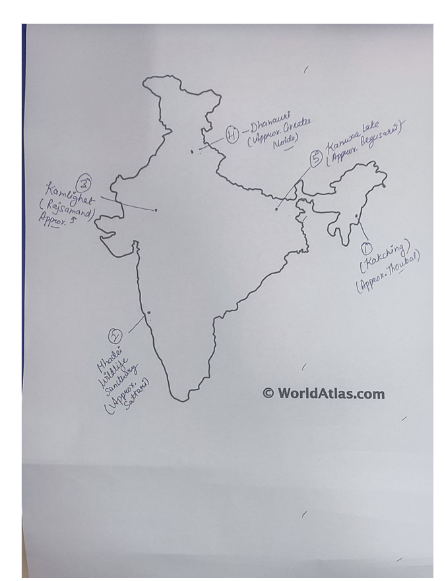
CARBON NEUTRAL VILLAGE : MEENANGADI IN KERALA
- In 2016, the Meenangadi panchayat envisaged a project called ‘Carbon neutral Meenangadi’, the aim being to transform Meenangadi into a state of carbon neutrality.
ACTIONS TAKEN
- An action plan was developed by convening village assembly meetings, engaging the entire community, including school students, youth, and technical and academic institutions, with specific assignments for each group.
- Socio-economic surveys and energy-use mapping were conducted as part of this comprehensive effort.
- A widespread awareness program was implemented through campaigns, classes, and studies.
- A greenhouse gas emission inventory was compiled to assess the environmental impact.
- A pioneering initiative known as 'tree banking' was introduced to support carbon-neutral activities, encouraging the planting of additional trees through the provision of interest-free loans.
- More than 150,000 trees were planted, and their growth progress is being monitored through geo-tagging.
- Focusing on local economic development, the promotion of LED bulb manufacturing and related micro-enterprises was initiated
Where to use:
Paper 1( Geography Optional ) : Environmental Management and Conservation , Environment remedial measures
Fortnightly KOSMOS MCQs PRACTICE
Question : 1
Consider the following statements regarding the Pusa-Biodecomposer:
- It is a liquid solution based on fungi, which effectively softens tough stubble, making it easily blend with soil in the field, functioning as compost.
- It swiftly transforms crop residues, animal waste, dung, and other refuse into valuable organic manure.
- It has been developed by the Indian Council of Agricultural Research (ICAR).
How many of the statements given above are correct?
- Only one
- Only Two
- Only Three
- None
Question : 2
With reference to Sinai Peninsula, consider the following statements:
- The Sinai Peninsula, situated in Israel, takes the form of a triangular landmass.
- Within this peninsula lies the Suez Canal, an artificial maritime passage linking the Mediterranean Sea to the Persian Sea.
Which of the statements given above is/are correct?
- Only One
- Only Two
- Both 1 and 2
- Neither 1 nor 2
Question : 3
Consider the following statements:
- The Amazon River basin spans across Guyana, Colombia, Ecuador, Bolivia, Suriname, French Guiana, and Venezuela.
- To the east, the Amazon rainforest finds its natural border in the Andes Mountains, while to the west, it meets the Atlantic Ocean.
Which of the statements given above is/are correct?
- Only One
- Only Two
- Both 1 and 2
- Neither 1 nor 2
Question : 4
With reference to Millet production India, consider the following statements:
- India holds the top position globally for millet production.
- Within India, Maharashtra stands as the leading state in the production of millets.
- The Indian government has proposed the designation of 2025 as the International Year of Millets to the United Nations.
How many of the statements given above are correct?
- Only one
- Only two
- All three
- None of the above
Question : 5
Consider the following statements:
- Sulfates and sea salt crystals are the main contributors to the formation of marine clouds.
- In unpolluted maritime atmospheres, marine clouds exhibit larger droplets, resulting in increased light reflection.
- The implementation of Marine Cloud Brightening (MCB) can effectively decrease the occurrence and intensity of coral bleaching events.
How many of the above statements are correct?
- Only one
- Only Two
- All three
- None
Question : 6
With reference to technological interventions to curb air pollution in India, consider the following statements:
- Sulfur salts constitute the core components of dust suppressants, where they are combined with water and subsequently applied to road surfaces.
- The Wind Augmentation and Air Purifying Unit (WAYU) technology is designed to counteract contaminants by employing ionization techniques.
- Smog towers serve as air purifiers with a specific focus on diminishing particulate matter and pollutants within extensive urban areas.
How many of the statements given above are correct?
- Only one
- Only two
- All three
- None of the above
Question : 7
With reference to Biomass Co-Firing, consider the following statements:
- The practice of substituting a portion of the fuel with biomass at coal thermal plants is known as biomass co-firing.
- Under Priority Sector Lending (PSL), the Ministry of New and Renewable Energy (MNRE) has granted approval for 'Biomass pellet manufacturing' as a qualifying activity.
Which of the statements given above is/are correct?
- Only 1
- Only 2
- Both 1 and 2
- Neither 1 nor 2
Question : 8
Consider the following statements:
- Land Degradation Neutrality (LDN) entails ensuring the availability of sufficient healthy and productive natural resources through the prevention of degradation wherever feasible and the rehabilitation of already degraded land.
- The objective of the Bonn Challenge is to restore 350 million hectares of the world's deforested and degraded land by 2030.
Which of the statements given above is/are correct?
- Only 1
- Only 2
- Both 1 and 2
- Neither 1 nor 2
Question : 9
Consider the following statements:
Statement I: Green hydrogen, as per the Ministry of New & Renewable Energy, is characterized by hydrogen production with emissions not exceeding 2 kg of carbon dioxide per kg of hydrogen.
Statement II: India's criteria for green hydrogen production allow for the utilization of biomass, which, when combusted, results in the release of carbon emissions.
Which one of the following is correct in respect of the above statements?
- Both Statement-I and Statement-II are correct and Statement-II is the correct explanation for Statement-I
- Both Statement-I and Statement-II are correct and Statement-II is not the correct explanation for Statement-I
- Statement-I is correct but Statement-II is incorrect
- Statement-I is incorrect but Statement II is correct
Question : 10
Consider the following statements :
- NGT is a dedicated institution established under the provisions of the Environment Protection Act, 1986.
- The appointment of the tribunal's Chairperson is made by the Chief Justice of India.
- The total membership of NGT should consist of no fewer than ten members.
How many of the statements given above are correct?
- Only one
- Only two
- All three
- None
Question : 11
With reference to coastal management in India, consider the following statements:
- The Ministry of Environment, Forest & Climate Change (MoEFCC) is responsible for establishing the hazard line along India's coastline to oversee shoreline modifications.
- The Biological Diversity Act of 2002 is directed towards the preservation of coastal regions and livelihoods, enabling the implementation of erosion control measures, while also delineating areas known as No Development Zones.
- The Coastal Management Information System (CMIS) plays a pivotal role in gathering coastal data from near-shore areas, essential for the planning and maintenance of protective structures.
How many of the statements given above are correct?
- Only one
- Only two
- All three
- None
Question : 12
Consider the following statements:
- In West Bengal, three rice varieties known as 'Aus,' 'Aman,' and 'Boro' are cultivated.
- Both West Bengal and Punjab are prominent rice-producing states that achieve high yields.
- According to the US Department of Agriculture (USDA), India held the title of the world's largest rice exporter, contributing approximately 40% of the total global rice exports.
- The top destinations for Indian basmati rice include Iran, Saudi Arabia, Iraq, the United Arab Emirates, and Yemen.
How many of the above statements are correct?
- Only one
- Only two
- Only three
- All four
Question : 13
Consider the following pairs:
Places. : Nearby location
- Kedarnath : On the way of Sonprayag
- Badrinath : On the way of Joshimath
- Yamunotri : On the way of Rudraprayag
Which of the above mentioned pairs are correct?
- One pair
- Two pairs
- Three pairs
- None
Question : 14
With reference to Green Credit Programme , consider the following statements:
- The ‘Green Credit’ means a singular unit of an incentive provided for a specified activity, delivering a positive impact on the environment.
- It was first announced in the 2023 -24 Union Budget with a view to leverage a competitive market-based approach and incentivize voluntary environmental actions of various stakeholders.
Which of the above mentioned statements is/ are correct ?
- Only 1
- Only 2
- Both 1 and 2
- Neither 1 nor 2
Question : 15
Why is there a great concern about the ‘ micro beads ‘ that are released into the environment?
- They are considered harmful to marine ecosystems.
- They are considered to cause skin cancer in children.
- They are small enough to be absorbed by crop plants in irrigated fields.
- They are often found to be used as food adulterants
Share the article
Edukemy’s Current Affairs Quiz is published with multiple choice questions for UPSC exams
MCQ
Get Latest Updates on Offers, Event dates, and free Mentorship sessions.

Get in touch with our Expert Academic Counsellors 👋
FAQs
Geography Current Affairs focuses on the contemporary issues, events, and developments in the field of geography. It covers recent geographical phenomena, environmental changes, geopolitical shifts, and related news. This differs from regular geography studies which may focus more on foundational concepts, historical contexts, and theoretical frameworks.
Updates are provided regularly to ensure that subscribers stay informed about the latest developments in geography. Typically, updates are provided on a fortnightly basis, depending on the frequency of significant events and changes in the field.
Absolutely. Geography Current Affairs serves as a valuable resource not only for Geography optional but also for GS papers, especially GS Paper 1 (covering Indian Heritage and Culture, History, and Geography of the World and Society) and GS Paper 3 (covering Technology, Economic Development, Biodiversity, Environment, Security, and Disaster Management). It aids in building a holistic understanding of various topics and strengthens answer-writing skills by incorporating contemporary examples and perspectives.
Geography Current Affairs holds immense importance for UPSC preparation, particularly for aspirants opting for Geography optional. It helps candidates stay updated with the latest developments, geographical phenomena, environmental issues, and geopolitical shifts worldwide, aligning them with the dynamic nature of the subject as tested in the UPSC examinations.

